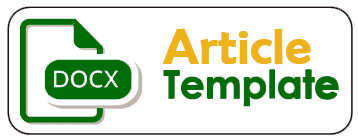Peningkatan Pengetahuan tentang Deteksi Dini Anemia pada Remaja Putri
DOI:
https://doi.org/10.36565/jak.v7i1.721Keywords:
anemia, health education, teenagersAbstract
Anemia is a public health problem in Indonesia that can be experienced by all age groups from toddlers to old age. In Indonesia, around 12% of boys and 23% of girls suffer from iron deficiency anemia. Adolescent girls (rheumataries) are prone to suffering from anemia because they lose a lot of blood during menstruation. Adolescent girls who suffer from anemia may later be at risk of developing anemia during pregnancy. The aim of this community service is to increase the knowledge of young women in recognizing, understanding and early detection of anemia. The target is 30 female students of SMP N Jambi. Community service methods include lectures, discussions, mentoring. The results of the service showed that students' knowledge increased after being given health education about early detection of anemia by 90%. Recommended for young women to increase their understanding of anemia by participating in counseling organized by health workers and broadening their horizons through print and electronic media
References
1. Rachmi, C. N. et al. Buku Panduan Untuk Siswa Aksi Bergizi: Hidup Sehat Sejak Sekarang Untuk Remaja Kekinian. (Jakarta: Kementerian Kesehatan Republik Indonesia, 2019).
2. Februhartanty, J., Ermayani, E., Rachman, P. H., Dianawati, H. & Harsian, H. Gizi dan Kesehatan Remaja. (Southeast Asian Ministers of Education Organization Regional Centre for Food and Nutrition (SEAMEO RECFON) Kementerian Pendidikan dan Kebudayaan Republik Indonesia, 2019).
3. Kementerian Kesehatan RI. Pedoman Pencegahan dan penanggulangan Anemia pada Remaja Putri dan Wanita Usia Subur (WUS). (Indonesia: Kemenkes RI, 2018).
4. Kemenkes RI. Pedoman pemberian Tablet Tambah Darah (TTD) bagi remaja putri. (Direktorat Gizi Masyarakat Direktorat Jenderal Kesehatan Masyarakat: Kementerian Kesehatan2020, 2020).
5. Pritasari, Damayanti, D. & Tri, L. N. Gizi dalam daur kehidupan. (Pusat Pendidikan Sumber Daya Manusia. Badan Pengembangan dan Pemberdayaan Sumber Daya Manusia Kesehatan, 2017).
6. Sari, V. M. & Rahmatika, S. D. Gambaran Kejadian Anemia pada Remaja Putri di Kabupaten Cirebon. Colostrum J. Kebidanan 2, 33–37 (2021).
7. Nurbadriyah, W. D. Anemia Defisiensi Besi. (Yogyakarta: Deepublish Publisher, 2019).
8. Widyanthini, D. N. & Widyanthari, D. M. Analisis Kejadian Anemia pada Remaja Putri di Kabupaten Bangli, Provinsi Bali, Tahun 2019. Bul. Penelit. Kesehat. 49, 87–94 (2021).
9. Putri, S. K., Jeki, A. G. & Fatmawati, T. Y. Status Gizi, Tingkat Konsumsi Zat Gizi Besi (Fe) dan Siklus Menstruasi Dengan Kejadian Anemia Remaja Putri. J. Diskurs. Ilm. Kesehat. 2, 9–15 (2024).
10. Chandra, F., Junita, D. & Fatmawati, T. Y. Tingkat pendidikan dan pengetahuan ibu hamil dengan status anemia. J. Ilm. Ilmu Keperawatan Indones. 9, 653–659 (2019).
11. Amini, N. A. Gambaran Tingkat Pengetahuan Tentang Anemia Pada Siswi SMP Ihsaniyah Tegal. ejournal Poltek Tegal 13–14 (2020).
12. Merita, Junita, Dini, Rahmadhani, D. Y. Pos Gizi Terpadu pada Komunita Adat Suku Anak Dalam (SAD). Sekolah Tinggi Ilmu Kesehatan Baiturrahim (2020).
13. Dinas Kesehatan Provinsi Jambi. Profil Indonesia Kesehatan 2018. Profil Kesehatan 2018 (2019).
14. Par’i, H. M., Wiyono, S. & Harjatmo, T. P. Penilaian status gizi. (Jakarta. Kementerian Kesehatan 2017, 2017).
Downloads
Published
Issue
Section
License
Copyright (c) 2025 Jurnal Abdimas Kesehatan (JAK)

This work is licensed under a Creative Commons Attribution-ShareAlike 4.0 International License.
Authors who publish with this journal agree to the following terms:
- Authors retain copyright and grant the journal right of first publication with the work simultaneously licensed under a Creative Commons Attribution License that allows others to share the work with an acknowledgment of the work's authorship and initial publication in this journal.
- Authors are able to enter into separate, additional contractual arrangements for the non-exclusive distribution of the journal's published version of the work (e.g., post it to an institutional repository or publish it in a book), with an acknowledgment of its initial publication in this journal.
- Authors are permitted and encouraged to post their work online (e.g., in institutional repositories or on their website) prior to and during the submission process, as it can lead to productive exchanges, as well as earlier and greater citation of published work (See The Effect of Open Access).








